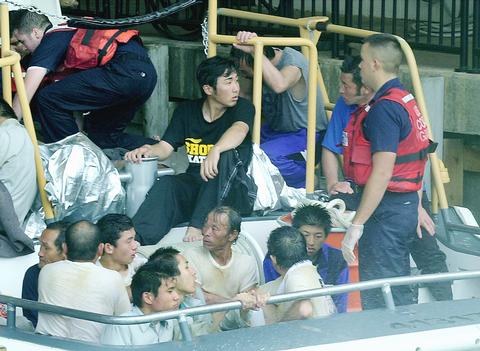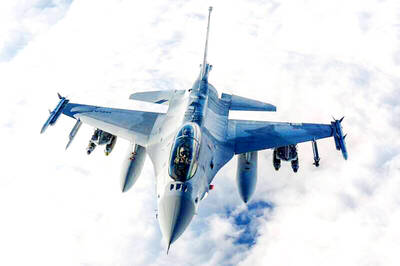Rescue crews held out hope that they would find nine people who were in a Japanese fishing vessel that sank to the bottom of the Pacific Ocean after colliding with a US Navy nuclear-powered attack submarine.
Twenty-six survivors who were stranded amid the debris and covered with diesel fuel from the crash were brought to shore. The boat was carrying high school students who were learning how to fish.
The USS Greeneville came up under the 54m boat, ripping the engine room open and causing two resounding booms. Seconds later, water flooded the vessel, sinking it within minutes, said a coast guard translator describing the Friday collision 14km south of Waikiki.

PHOTO: AP
"Most of the people were below deck in the rooms or galley," said Petty Officer Michael Carr, who interviewed the survivors. "After the lights went out, everyone started yelling that the water was coming into the ship. That's when most of the people we saw started fleeing."
The fishing boat carried 35 people, including 20 crew members, two teachers and 13 students from the Uwajima Fisheries High School in the southwestern Japanese prefecture of Ehime. The missing included four high school students, two teachers and three crew members.
The boat, the Ehime Maru, left Japan on Jan. 10 to hunt for tuna, swordfish and shark.
The navy and coast guard hoped to find people clinging to the wreckage. "We found some debris earlier today, but no sign of survivors yet," said coast guard spokesman Lieutenant Greg Fondran.
The survivors huddled in three life rafts before being rescued. Petty Officer Thomas Kron, who was on the coast guard patrol boat, said the survivors were soaked with diesel fuel that spilled when the boat sank.
"They seemed like they were in shock. They were fatigued by the time we got there," he said. "Some of them were seasick and some of them were glad to see us."
The survivors were taken to the coast guard station at Honolulu Harbor's Sand Island. Some walked off on their own; others were carried on stretchers and covered in blankets.
Fondran said none appeared to be seriously injured. A wounded shoulder appeared to be the worst injury, he said.
Twelve were taken to local hospitals for treatment of minor injuries while 14 were cared for at the base, including showers to wash off the fuel, he said.
Dressed in blue jump suits, the survivors lined up to use the single phone available to them at the base, to let their families in Japan know that they were safe.
Japanese officials said they were scrambling to coordinate a response to the accident.
"It's a bit chaotic right now," said Uwajima municipal official Masanori Mori. "There's a great deal of shock."
Mori said the Ehime Prefectural government had set up a crisis center to assist families and gather information on the accident.

LONG FLIGHT: The jets would be flown by US pilots, with Taiwanese copilots in the two-seat F-16D variant to help familiarize them with the aircraft, the source said The US is expected to fly 10 Lockheed Martin F-16C/D Block 70/72 jets to Taiwan over the coming months to fulfill a long-awaited order of 66 aircraft, a defense official said yesterday. Word that the first batch of the jets would be delivered soon was welcome news to Taiwan, which has become concerned about delays in the delivery of US arms amid rising military tensions with China. Speaking on condition of anonymity, the official said the initial tranche of the nation’s F-16s are rolling off assembly lines in the US and would be flown under their own power to Taiwan by way

CHIP WAR: The new restrictions are expected to cut off China’s access to Taiwan’s technologies, materials and equipment essential to building AI semiconductors Taiwan has blacklisted Huawei Technologies Co (華為) and Semiconductor Manufacturing International Corp (SMIC, 中芯), dealing another major blow to the two companies spearheading China’s efforts to develop cutting-edge artificial intelligence (AI) chip technologies. The Ministry of Economic Affairs’ International Trade Administration has included Huawei, SMIC and several of their subsidiaries in an update of its so-called strategic high-tech commodities entity list, the latest version on its Web site showed on Saturday. It did not publicly announce the change. Other entities on the list include organizations such as the Taliban and al-Qaeda, as well as companies in China, Iran and elsewhere. Local companies need

CRITICISM: It is generally accepted that the Straits Forum is a CCP ‘united front’ platform, and anyone attending should maintain Taiwan’s dignity, the council said The Mainland Affairs Council (MAC) yesterday said it deeply regrets that former president Ma Ying-jeou (馬英九) echoed the Chinese Communist Party’s (CCP) “one China” principle and “united front” tactics by telling the Straits Forum that Taiwanese yearn for both sides of the Taiwan Strait to move toward “peace” and “integration.” The 17th annual Straits Forum yesterday opened in Xiamen, China, and while the Chinese Nationalist Party’s (KMT) local government heads were absent for the first time in 17 years, Ma attended the forum as “former KMT chairperson” and met with Chinese People’s Political Consultative Conference Chairman Wang Huning (王滬寧). Wang

OBJECTS AT SEA: Satellites with synthetic-aperture radar could aid in the detection of small Chinese boats attempting to illegally enter Taiwan, the space agency head said Taiwan aims to send the nation’s first low Earth orbit (LEO) satellite into space in 2027, while the first Formosat-8 and Formosat-9 spacecraft are to be launched in October and 2028 respectively, the National Science and Technology Council said yesterday. The council laid out its space development plan in a report reviewed by members of the legislature’s Education and Culture Committee. Six LEO satellites would be produced in the initial phase, with the first one, the B5G-1A, scheduled to be launched in 2027, the council said in the report. Regarding the second satellite, the B5G-1B, the government plans to work with private contractors